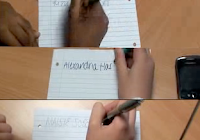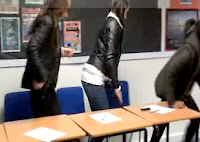Titles:
 For our titles we decided that the teacher would write 'featuring' on the board, then we would edit in names of characters afterwards. Our idea would be that the teacher says 'you may begin your lines', and a split screen would show the three girls writing their names and the characters they are playing. For the titles at the beginning, we decided on a simple black screen and white writing showing who edited, filmed and featured in the opening.
For our titles we decided that the teacher would write 'featuring' on the board, then we would edit in names of characters afterwards. Our idea would be that the teacher says 'you may begin your lines', and a split screen would show the three girls writing their names and the characters they are playing. For the titles at the beginning, we decided on a simple black screen and white writing showing who edited, filmed and featured in the opening. Introducing main characters:
The character's are introduced when the teacher says 'you may begin your lines', the camera then pans round the classroom which then stops at the characters, showing them bored. As they are in detention is may suggest that the girls are rebellious and don't follow school rules.
Introducing setting:
After the teacher says 'you may begin your lines', the camera pans round the classroom which establishes the setting. we used a panning movement to show the entire room instead of using separate shots because it gives it a sense of continuity from the beginning when the teacher writes featuring on the board.
Introducing genre:
 Our genre isn't introduced immediately because we wanted to build suspense. However when the characters receive the text from 'Unknown' saying 'IT'S TIME!', it becomes obvious to the audience that the characters are not the typical school children, and this is where the genre first becomes clear. We then fully establish genre when they run out and the split screen shots show them in fighting poses and our title appears saying 'Teen Spy', which tells the audience what type of film it is going to be.
Our genre isn't introduced immediately because we wanted to build suspense. However when the characters receive the text from 'Unknown' saying 'IT'S TIME!', it becomes obvious to the audience that the characters are not the typical school children, and this is where the genre first becomes clear. We then fully establish genre when they run out and the split screen shots show them in fighting poses and our title appears saying 'Teen Spy', which tells the audience what type of film it is going to be.Sound:
We used diegetic sound to further establish setting, its important that the teacher said 'you may begin your lines' because the audience may be confused as to why there were only three people in a class. Furthermore, this made the audience aware that the pupils were in detention.
The opening begins with calm music as not much action is happening. But by the end of the opening there is a contrast in the music as it becomes faster and intense showing that there is action and something big or unexpected is about to happen. We also used digetic sound to exaggerate and emphasis the ticking of the clock. This helped show its significance and let the audience know that they have somewhere to be in such a little time.









